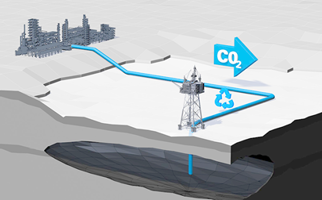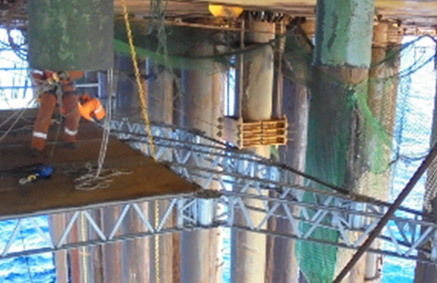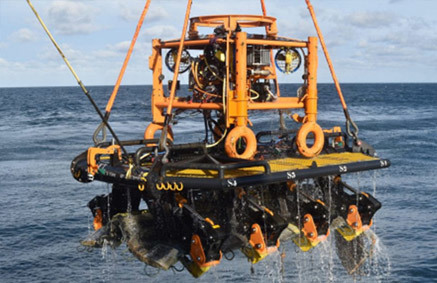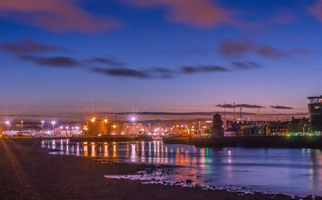
Only a few Operators (10 out of 50) are reporting in this category but for those that do they include:
Access systems, such as walk to work and modular deck extensions to increase deck space and ‘energy pods’ for lighthouse mode using renewables.
New this year is post-decommissioning monitoring via autonomous underwater vehicles.
Shaped charges to cut subsea tie-rods, topsides deployed ROVs to remove conductor anodes, and diver-less riser/pipeline separation by ROV.
Growing use of digital solutions, including for predictive decommissioning modelling, scheduling and optimisation.
-
Operators’ technology focus spreads across the entire Decommissioning cycle
-
It encompasses asset late-life management, work planning, topsides removal and subsea decommissioning
-
Decommissioning technologies are gaining interest as more operators have assets in the late life stage. In 2024 there are 12 Operators reporting technologies in this area
As Decommissioning is a relatively new field, at least on the scope and scale it has recently reached in the UKCS, it is not surprising to see that Operators are targeting innovative and less than fully proven technologies (over 50% of the entries)
Operators seek to participate in decommissioning technology development and adoption, complementing the vendors’ efforts (circa 40% of technologies)
Readiness definitions: Early Development (TRL 1-4), Late Development/Pilot (TRL 5-7), Early commercialisation (TRL 8), Proven (TRL 9)
Operator focus remains on alternative power generation technologies, power generation efficiency improvements and peak load management to reduce emissions during late life and decommissioning phases. Also access systems such as walk to work to allow decommissioning personnel to have accommodation in the field without adding to platform headcount, bespoke subsea tooling.
- Transportable, autonomous energy container combining wind turbine, solar panels and battery storage for use on platforms in lighthouse mode
- TRL 9 Commercially Available
- Emission reduction action plan tool - Portfolio of prioritised equipment and plant modifications to improve efficiency, reduced power and / or flaring & venting in a drive to reduce Offshore Scope 1 GHG emissions in-line with industry targets.
- TRL 9 Proven technologies
- Walk to work modular gangway - Fully connected gangway from CSV to platform in northern North Sea providing walk to work capability.
- TRL 9 Commercially Available
- Peak load management to reduce emissions - Utilising load bank and battery technology to manage peak load and reduce need for higher emission diesel driven power generation
- TRL 9 Commercially Available
- Wellhead retrieval clamp - ROV deployed, horizontal access, non-hydraulic clamp for subsea wellhead removal
- TRL8 Early Commercialisation
- Novel subsea tooling suite - Development of bespoke decom support tooling through specialist contractor.
- TRL 8 Early Commercialisation
- Variable buoyancy system for subsea operations - To deploy tooling at significant excursion from marine crane (alternative to air bags).
- TRL 5-7 Late Development/Pilot
Innovations include standard grillage design and cutting technologies taken from well abandonment deployed for topsides dismantling. Emerging technologies include using internal deballasting to float off and tow jackets and topsides to shore for disposal, and two-part conductor removals on GBS structures. New this year, direct load in of jackets, internal deballasting and use/reuse of standard grillage designs, and modular deck extensions to increase deckspace for well P&A and decommissioning
- Direct load-in of jackets – to decommissioning yard, removing the need for prior transfer.
- TRL 9 Commercially Available
- Standard grillage design – To enable reuse for multiple jackets, providing economies of scale for multiple scopes to single contractor.
- TRL 9 Commercially Available
- Piece small destruct – Use of a gin pole was to remove the top section of a derrick
- TRL 9 Commercially Available
- Deballasting jacket removal - To enable removal via a single lift. De-ballast leg tanks and inject air to displace water, to give the jacket additional buoyancy to allow it to be upended and removed in the horizontal.
- TRL 9 Commercially Available
-
Modular deck extensions - Modular alternative access system which gives increased deck space for decommissioning and well P&A activities
-
TRL 8 Early commercialisation
-
Modular Deck - construction and maintenance programmes demand bespoke methods of access that deliver optimum levels of safety and efficiency. QuikDeck® can be built in the air, or on the ground and then hoisted into location

- Conductor recovery cutter - Decom tool to shear multiple string casings at surface, rather than traditional methods
- TRL 8 Early Commercialisation
- Two part conductor removals – For GBS structures, conductors separated, and the upper sections recovered with a topsides single lift, the free-standing lower sections recovered later from a construction vessel
- TRL 8 Early Commercialisation
Operators have adopted crane deployed utility ROVs with specific decommissioning tooling skids, diverless riser/pipeline separation by ROV tooling, adopting a factory approach contracting strategy, and use of low-cost anchor handling vessels for flowlines. The latter also now being considered for structure recovery. New this year are remote cell access for removal of attic oil in GBS structures, piece large conductor recovery and navigational aids for unmanned platforms.
- Integrated engineered reefs - Re-engineering retired assets and integrating them into purpose-built reefs instead of removing them.
- TRL 9 Commercially Available
- TRL 9 Commercially Available
- Cardinal buoys in lieu of guard vessels - To mark partially decommissioned structures as a safe, cost-efficient alternative
- TRL 9 Commercially Available
- Permanent artificial reefs for pipeline protection - To provide more environmentally robust pipeline/cable protection for subsea developments or decommissioned infrastructure that does not add to the ocean’s micro-plastic inventory. This project will evaluate the benefits of creating artificial reefs using new sustainable products as pipeline/cable protection and prove the potential to use recycled decommissioned concrete mattresses and rock bags in their manufacture.
- TRL 9 Proven Technology
Utility ROV Services – Swiss army knife ROV based decommissioning tool skid - de-burial of assets, recovery of concrete mattresses, cutting and recovery of pipeline, spools & flexibles, clearance of debris and burial of exposed pipeline ends
Technology example link
- Flexible riser disconnections - To cut flexible risers safely and efficiently to enable the removal of adjacent topsides.
- TRL 9 Commercially Available
- Adopting a factory approach - New/alternative contracting strategies to carry out removal of subsea infrastructure rather than piecemeal
- TRL 9 Commercially Available
- Use of shaped charges - Specialised vendor to cut tie rods
- TRL 9 Commercially Available
- Navigational aids for unmanned platform - Solar powered with remote monitoring after the topsides is down manned.
- TRL 9 Commercially Available
- TRL 9 Commercially Available
- Novel subsea tooling suite - Development of bespoke decom support tooling through specialist contractor.
- TRL 8 Early Commercialisation
- Crane-free decommissioning – Use of an anchor handler’s winch for recovering small structures (up to circa 200-300Te) and then transporting them to shore by towing.
- TRL 1-4 Early Development
Operators are challenging conventional thinking by looking at the impact on the environment of removal activities compared with benefits and risks of “leave in place”. Also included are energy efficient solutions to protect installations without guard vessels, and low carbon solutions for power generation, monitoring and communications. New this year is post-decommissioning monitoring via autonomous underwater vehicles.
- Integrated Engineered Reefs - The idea is to change the conversation from Sea dumping to Habitat building by putting more structure in. Australia are re-engineering retired assets and integrating them into purpose-built reefs. Instead of removing these valuable habitats, enabling operators to super charge them by putting more in
- TRL 9 Proven Technologies
- Cardinal buoys in lieu of guard vessels - Offshore deployment of cardinal buoys to mark partially decommissioning structures as safe cost-efficient solution; already deployed at two of the Operators assets
- TRL 9 Proven Technologies
- Permanent Artificial Reefs for Pipeline Protection - More environmentally robust pipeline/cable protection is required for future Oil & Gas subsea developments or decommissioned infrastructure protection that does not add to the ocean’s micro-plastic inventory. This project will evaluate the benefits of creating Artificial Reefs using the patented “Reef-Cube” design and fully develop the “Reef-Bag”, “Reef Matt” & “Grout-EcoBag” products as pipeline/cable protection and prove the potential to use recycled decommissioned concrete mattresses and rock bags in their manufacture.
- TRL 9 Proven Technology
- Topsides Cell Access - Bespoke ROV tooling to intervene on previously inaccessible pipework inside base of concrete leg to recover potential trapped hydrocarbons.
- TRL 5-7 Late Development/Pilot
- Post decommissioning monitoring via autonomous vehicles - High resolution camera-equipped autonomous underwater vehicles, to better understand end-of-life oil fields in the North Sea.
- TRL 5-7 Late Development/Pilot
- Navaid – GBS structure leg height after topsides lift will be circa +8m, which is too low for a conventional GBS navaid. Base case option is to install an additional concrete tower but marine buoys will be investigated as an alternative.
- TRL 1-4 Early Development
Innovations include digital technologies such as predictive decommissioning modelling, scheduling & optimisation. Emerging technology includes development of a haptic hand user interface to control large robotic systems in decommissioning.
- Predictive decommissioning modelling - Analytics tools to provide a mathematical model to provide decision makers with a near real-time 'what-if' scenario decision making capability
- TRL 9 Commercially Available
- Virtual Emission Monitoring System - Decommissioning involves greater reliance on platform diesel generators and vessel transportation. These constitute over 90% of decommissioning related emissions. an AI-based tool which utilises operational parameters that are already collected by operators along with historical emissions measurements to provide an online emissions monitoring system for turbines, engines and marine vessels.
- TRL 9 Commercially Available
- Software for decom scheduling and optimisation - To assess removal options, suitability of equipment and optimise plans.
- TRL 5-7 Late Development/Pilot
- Haptic Hand – Provides an effective and intuitive user interface to control large robotic systems used in the decommissioning process.
- TRL 1-4 Early Development
Operators are reporting novel technologies in waste management & recycling, including explosive collapse of structures to reduce height for improved access by remote machinery. Emerging technologies include digital waste management and tracking,, and conversion of recovered concrete mattresses into advanced paving systems for onshore re-use.
- Explosive collapse of structures - Using explosive technology to reduce the height of structures delivered onshore for dismantling. The technology can reduce working at height risk and facilitate access by remote machinery to safely progress dismantling work.
- TRL 9 Commercially Available
- Digitalising the waste tracking & management process – To improve transparency, visibility, data quality & reporting, and reduce incidents
- TRL 5-7 Late Development/Pilot
- Conversion of concrete mattresses - into advanced permeable paving systems for storm-water management by taking a circular economy approach and helping to alleviate flooding across the UK.
- TRL 1-4 Early development








